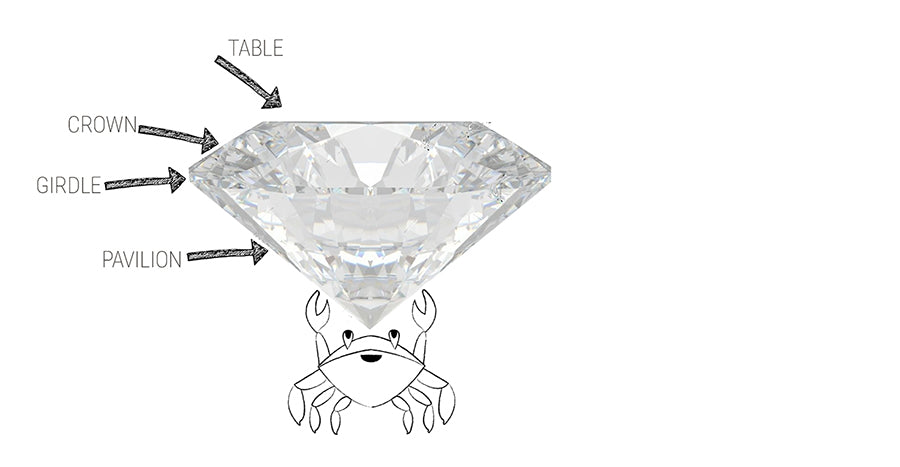What to Know Before You Put a Ring On It

I never understood the interest in diamonds until a certain one came across my path. Friends were getting married, and the groom had inherited an Art Deco engagement ring and band from his favorite aunt. Both were modest and dated back to the 1920s. The diamond on the engagement ring wasn’t especially big, but boy, did that thing make itself known, shooting what seemed like purple and red beams at me.
The experience made me ask what made that little diamond have such Big Diamond Energy? The answer taught me what I really loved: the imperfect, hand-cut charm I’ve come to think of as the best valued diamonds with which to design and craft.
A turn to history
The discovery of diamonds is believed to go all the way back to the 4th century in India. After the fall of the Roman Empire, the West entered the Dark Ages. With the rise of Christianity, religious figures looked down on the superstitions that surrounded early diamond jewelry, which fell out of favor in the West but continued to be in use in the Hindu and Muslim East. Their light could not be dimmed forever, and 1,000 years later, diamond appreciation found its way back to Europe as it rolled into the Renaissance.
Then, during the Enlightenment, as ships criss-crossed the Atlantic between the New and Old Worlds, Brazil became the main supplier of diamonds. Early cuts from this era were called “old mine” and were more square in shape. As the 1800s progressed, the Old European and transitional cut shapes — the more familiar round shapes we know now — became more popular. (You see them in today’s antique jewelry market.)
As the Civil War ended in the United States, the Kimberly deposits in South Africa were discovered. The descent into darkness starts here actually and metaphorically. By this time, surface mining had given way to underground mining. Soon, De Beers, founded by two Afrikaners, controlled nearly 90% of the world’s diamond mining, selling the myth of manufactured scarcity to the world.
The ubiquitous 58-faceted brilliant cut appeared in the 1940s as did the famous slogan, “Diamonds are forever.” Machines for diamond-shaping came into use in the 1970s, and by the 1990s, the vast majority of diamonds were cut by machines. Technology helped map geologic conditions that could yield diamond deposits worldwide, leading to the opening of mines in Australia. Technological advancements also brought lasers to the cutting table, offering a marriage of convenience and conformity.
By 2000, mines opened near Earth’s magnetic North Pole (read: Canada). They operate outside of the De Beers empire. The latest chapter in the diamond story? Lab-grown diamonds. They match the questionably mined “perfect” diamonds of the late 20th century.

Character over perfection
“Perfect is the enemy of the good,” wrote the philosopher Voltaire, and I couldn’t agree more. Once lasers replaced hands, diamond cuts became about maximum yield. The human hands that had brought the best character of the Art Deco diamond to the
surface and so moved me had been devalued by an ethos that elevated profit over the human touch.
Today, lab-grown diamonds ride the technological tsunami of our modern world, where people eliminate organic sources and manufacture the product themselves. These man-made, lab-grown rocks are more reasonably priced and promoted as more ethical because they’re not extracted from the earth and have no human conflicts attached to them, but like bitcoin mining and AI data centers, they take an incredible amount of energy. The perfected end product is indistinguishable from the top-rated mined diamonds that max out the 3 Cs— color, clarity, and cut — of the graded diamond world.
What stone(s) for my ceremonial jewelry?
As a '90s kid, the reuse, reduce, recycle mantra was drilled into my head. So I would recommend starting with your family to see if they have any diamonds or sapphires not being appreciated.
If you do not have this luxury and want to reduce and recycle, you can shop for an antique stone. The oldest diamonds traded in the Antique circuit date back to the 1700s and feature Old Mine cuts. The Old European and transitional cuts are also available and easier to find. (Think estate sales, antique stores, auctions, and retailers of antique jewelry..) You may also consider rose-cut diamonds, which, like Old Mine diamonds, were popular during the Georgian and Victorian eras and came from India. Unlike traditionally cut diamonds — any jewelry that includes pavilions — rose-cut diamonds can be worn lower on the finger because their settings don’t have to be elevated to accommodate the culet, the point at the bottom of the diamond where the pavilion facets meet. Rose-cut diamonds reflect light subtly instead of blinding people with their bling. (Think 1990s headlights versus LED lights) They’re super comfortable to wear, and if you’re into that stone-skin contact-energy, you can have the diamond touch your finger.
If you really want a new stone to call your own, consider one that comes from Canadian diamond mines like Diavik and Ekati. They’re outside of DeBeers control, are mindful of the First Nations people, and work to tend the land as best they can.
Sapphires are another great alternative to diamonds. Generally the choice of the royal family, they come in a surprising range of colors; and there are mines in Montana! Two-tone Parti sapphires display multiple colors within a single stone. Sapphires are also almost as hard as diamonds. They’re a 9 on the Mohs hardness scale, while diamonds are a 10.
A word about wedding bands
Wedding bands really shouldn’t be silver. Silver is a soft metal, so it’s more easily damaged, and silver jewelry doesn't have nearly as high a resale value as gold.
If the groom doesn’t care for yellow gold, white gold is an option but remember that white gold is often plated with rhodium, because white gold is kind of dull even after being polished. Unless requested, at Shipwreck Montauk, we never plate over white gold.
If yellow gold isn’t your cup of tea either, try a mild 10k yellow gold with a brushed finish instead of a high polish. You can also go with platinum, which is a darker silver and a dull color but so strong you can open bottles with it, and your partner can make sad jokes about that being the way you honor your marriage.
The dullness of platinum rings may appeal to men, because many don’t want to wear a shiny object. Instead, they opt for rings with an industrial vibe, like titanium rings because they come in a more masculine black. They’re often thick rings, though, so for those not used to wearing jewelry, they can feel like handcuffs. (No one wants their marriage to feel like prison, right?) Wedding bands should feel comfortable and wear like shadows.
We further advise couples to engrave a special message inside their rings to further bond them. If no phrase comes to mind, consider engraving your wedding date, so you never forget your anniversary.
Jewelry for active people
Besides variables like stones, their cut, provenance, and type of metal, you should also keep in mind how active you or the person receiving a gift of jewelry may be. If you purchase a ring with stones held by prongs, they may be more easily wrecked in day-to-day life.
Jewelry featuring stones held by prongs may have worked for women in the 1950s and maybe today’s trad wives but no more. People don’t play traditional gender roles as often. Women don’t spend all their time cooking meals, tending to children, or making casseroles and aspics for husbands and dinner parties. They have jobs, work out, garden. If they wear rings with prongs, the jewelry could scratch the faces of their loved ones and pets, catch on clothing, and grow loose more quickly than jewelry with bezel or channel settings.
Old school jewelers may push you toward rings with prong-held jewels and reassure you that you can always bring them back in to be retipped and checked to ensure their security. It’s a great way to lure you back to the store to buy more jewelry. But what if your ring was built to last a very, very long time, not snag on clothing, scratch your kids face, or snap off, loosening the jewels?
But let’s face it: Active people lose a lot of jewelry or damage them in some way. A good way to prepare is to get key pieces molded or 3D-scanned so that, if you lose them, you can get them reproduced more easily.
Jewelry as investment
Unless it’s costume jewelry, jewelry can be an investment, and if we’re talking wedding rings, then it’s your first investment as a couple.

And I’ve heard it said that wedding rings should equal the value of two months’ salary — what unadulterated marketing hogwash. Do the best with what you have, and if you can’t afford much, go small. Buy durable stones like diamonds or sapphires that don’t break easily, because it’s good to purchase jewelry that will retain or build value. Commit to real materials with enduring value, like gold. Hopefully, you’ll never have to melt down your jewelry, but if you do, at least it will be worth something beyond the memories it holds.
I hope this manifesto of sorts helps you avoid bad decisions as you shop for jewelry. We’re not responsible for the choice you make for a partner.
